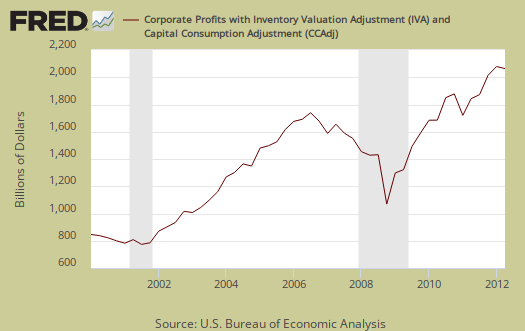The BEA released corporate profits for Q2 2012 along with the GDP. Corporate profits after tax declined -1.4% from Q1 2012 to $1,648.3 billion. Corporate profits after tax are also up 13.3% from a year ago.

Corporate profits with inventory valuation and capital consumption adjustments, after tax, increased 1.1% from last quarter to $1,462.2 billion and are up 3.3% from one year ago.

Corporate profits with inventory valuation and capital consumption adjustments, pre-tax, increased $10.4 billion to $1,910.5 billion, or up 0.5% from Q1 and still up 6.1% from a year ago. These are profits from current production.

Net cash flow, with inventory evaluation adjustment declined –0.6% from Q1 to $1,824.5 billion. This is no change from a year ago. These are the corporate funds available for investment according to the BEA.

Quarterly tax receipts for Q2 decreased -1.2% from Q1 to $448.2 billion.
What's most interesting is these profits are from outside the United States. Rest of the world profits increased $19.2 billion to $422.1 billion whereas domestic profits declined -$8.9 billion to $1,488.3 billion.
Domestic profits of financial corporations decreased $39.2 billion in the second quarter, compared with a decrease of $12.3 billion in the first. Domestic profits of nonfinancial corporations increased $30.4 billion in the second quarter, compared with an increase of $7.3 billion in the first. In the second quarter, real gross value added of nonfinancial corporations increased, and profits per unit of real value added increased. The increase in unit profits reflected an increase in unit prices and a decrease in unit nonlabor costs that was partly offset by an increase in labor costs. The rest-of-the-world component of profits increased $19.2 billion in the second quarter, in contrast to a decrease of $48.0 billion in the first.
The BEA reports corporate profits in a variety of ways and it seems whatever one's focus and political predilections are implies which number they use.
From the BEA's magic secret decoder ring guide to National Income and Product Accounts (large pdf), national income also uses inventory valuation and capital consumption adjustments. Their reasoning for inventory valuation is this:
Inventory valuation adjustment (IVA) is the difference between the cost of inventory withdrawals valued at acquisition cost and the cost of inventory withdrawals valued at replacement cost. The IVA is needed because inventories as reported by business are often charged to cost of sales (that is, withdrawn) at their acquisition (historical) cost rather than at their replacement cost (the concept underlying the NIPAs). As prices change, businesses that value inventory withdrawals at acquisition cost may realize profits or losses. Inventory profits, a capital-gains-like element in business income (corporate profits and nonfarm proprietors’ income), result from an increase in inventory prices, and inventory losses, a capital-loss-like element, result from a decrease in inventory prices.
The mysterious capital consumption adjustment, along with inventory valuations, derives current production income.
The private capital consumption adjustment (CCAdj) converts depreciation that is on a historical-cost (book value) basis—the capital consumption allowance (CCA)—to depreciation that is on a current-cost basis—consumption of fixed capital (CFC)—and is derived as the difference between private CCA and private CFC.
Since this is what the BEA uses for national accounts and makes much more sense from a business accounting perspective generally, seems the above before and after tax numbers are the right metrics to use when thinking about corporate profits from a national and macro-economic perspective.
If the above magic secret BEA decoder ring didn't make much sense, try this one:
Corporate profits with inventory valuation and capital consumption adjustmentsis the net current-production income of organizations treated as corporations in the NIPA's. These organizations consist of all entities required to file Federal corporate tax returns, including mutual financial institutions and cooperatives subject to Federal income tax; private noninsured pension funds; nonprofit institutions that primarily serve business; Federal Reserve banks; and federally sponsored credit agencies. With several differences, this income is measured as receipts less expenses as defined in Federal tax law. Among these differences: Receipts exclude capital gains and dividends received, expenses exclude depletion and capital losses and losses resulting from bad debts, inventory withdrawals are valued at replacement cost, and depreciation is on a consistent accounting basis and is valued at replacement cost using depreciation profiles based on empirical evidence on used-asset prices that generally suggest a geometric pattern of price declines. Because national income is defined as the income of U.S. residents, its profits component includes income earned abroad by U.S. corporations and excludes income earned in the United States by the rest of the world.

Recent comments